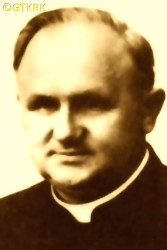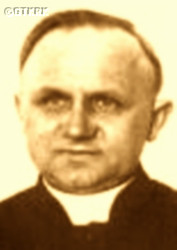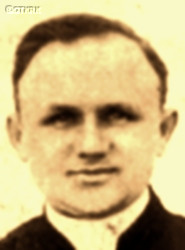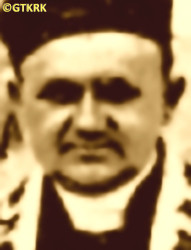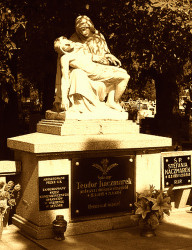Roman Catholic
St Sigismund parish
05-507 Słomczyn
85 Wiślana Str.
Konstancin deanery
Warsaw archdiocese, Poland
full list:
displayClick to display full list

searchClick to search full list by categories
wyświetlKliknij by wyświetlić pełną listę po polsku

szukajKliknij by przeszukać listę wg kategorii po polsku

Martyrology of the clergy — Poland
XX century (1914 – 1989)
personal data
surname
KACZMAREK
forename(s)
Theodore Nicodemus (pl. Teodor Nikodem)
function
diocesan priest
creed
Latin (Roman Catholic) Church RCmore on
en.wikipedia.org
[access: 2014.09.21]
diocese / province
Gniezno and Poznań archdiocese (aeque principaliter)more on
www.archpoznan.pl
[access: 2012.11.23]
academic distinctions
Philosopy MA
date and place
of death
21.09.1954

Sztumtoday: Sztum gm., Sztum pov., Pomerania voiv., Poland
more on
en.wikipedia.org
[access: 2022.01.28]
alt. dates and places
of death
21.10.1954
details of death
Participant of Greater Poland Uprising in 1918‐1919.
Military nurse during battles n. Wolsztyn and after ordination a chaplain in Gniezno.
After German invasion of Poland in 09.1939 (Russians invaded Poland 17 days later) and start of the World War II arrested on 11.09.1939 by the Germans.
Jailed in Margonin prison but on 27.09.1939 released.
On 12.12.1939 deported to the German‐run Germ. Generalgouvernement (Eng. General Governorate).
Settled in Kamionna n. Węgrów where helped the local parish priest.
To his parish returned on 13.03.1945, after German defeat in 1944/1945 and start of another Russian occupation.
In 1952, facing a ban on Corpus Christi procession public altars, led a procession during which the altar was set up on a moving car platform and stopped at precisely the same spots where traditional altars had usually been erected.
On 30.12.1952 arrested by the Russian controlled Commie‐Nazi secret police UB.
Jailed in Krotoszyn gaol.
On 06.01.1953 released.
On 22.03.1953 however arrested again.
Moved to infamous Rakowiecka Str. prison in Warsaw and accused by UB of failing to report „subversive”, clandestine activities — during German occupation — of his niece and her husband in clandestine resistance Home Army AK (part of the Polish Clandestine State) to the „relevant authorities”.
On 29.01.1954 sentenced in Warsaw to 5 years.
Jailed in Sztum prison.
There held for 6 months in a 1.2×3 m, single prison cell, in isolation.
There perished — refused necessary medical support when requested.
Officially the cause of death was quoted as „heart failure”.
cause of death
murder
perpetrators
Russians / Poles
sites and events
SztumClick to display the description, Warsaw (Mokotów)Click to display the description, GeneralgouvernementClick to display the description, Deportations from Reichsgau WarthelandClick to display the description, Reichsgau WarthelandClick to display the description, Collective responsibility („Hostages”)Click to display the description, Reichsgau Danzig‐WestpreußenClick to display the description, Ribbentrop‐MolotovClick to display the description, Pius XI's encyclicalsClick to display the description, Greater Poland UprisingClick to display the description
date and place
of birth
15.09.1895Birth certification on:
photos.szukajwarchiwach.gov.pl
[access: 2025.10.15]

Kościantoday: Kościan gm., Kościan pov., Greater Poland voiv., Poland
more on
en.wikipedia.org
[access: 2021.07.18]
parents
KACZMAREK John
🞲 ?, ? — 🕆 ?, ?

WĘCLEWSKA Stephanie
🞲 ?, ? — 🕆 ?, ?
presbyter (holy orders)
ordination
05.04.1919

Gnieznotoday: Gniezno urban gm., Gniezno pov., Greater Poland voiv., Poland
more on
en.wikipedia.org
[access: 2021.12.18]
Assumption of the Blessed Virgin Mary RC archcathedral churchmore on
en.wikipedia.org
[access: 2025.03.14]
positions held
1949 – 1953
dean — Krotoszyntoday: Krotoszyn gm., Krotoszyn pov., Greater Poland voiv., Poland
more on
en.wikipedia.org
[access: 2021.07.18] RC deanery
1946 – 1953
parish priest — Krotoszyntoday: Krotoszyn gm., Krotoszyn pov., Greater Poland voiv., Poland
more on
en.wikipedia.org
[access: 2021.07.18] ⋄ St John the Baptist RC parish ⋄ Krotoszyntoday: Krotoszyn gm., Krotoszyn pov., Greater Poland voiv., Poland
more on
en.wikipedia.org
[access: 2021.07.18] RC deanery
1945 – 1946
parish priest — Margonintoday: Margonin gm., Chodzież pov., Greater Poland voiv., Poland
more on
en.wikipedia.org
[access: 2022.07.16] ⋄ St Adalbert the Bishop and Martyr RC parish ⋄ Rogoźnotoday: Rogoźno gm., Oborniki pov., Greater Poland voiv., Poland
more on
en.wikipedia.org
[access: 2021.07.18] RC deanery
c. 1939 – 1945
priest — Kamionnatoday: Łochów gm., Węgrów pov., Masovia voiv., Poland
more on
en.wikipedia.org
[access: 2021.12.18] ⋄ Immaculate Conception of the Blessed Virgin Mary RC parish ⋄ Węgrówtoday: Węgrów urban gm., Węgrów pov., Masovia voiv., Poland
more on
en.wikipedia.org
[access: 2021.08.20] RC deanery
1933 – 1939
parish priest — Margonintoday: Margonin gm., Chodzież pov., Greater Poland voiv., Poland
more on
en.wikipedia.org
[access: 2022.07.16] ⋄ St Adalbert the Bishop and Martyr RC parish ⋄ Rogoźnotoday: Rogoźno gm., Oborniki pov., Greater Poland voiv., Poland
more on
en.wikipedia.org
[access: 2021.07.18] RC deanery
till 1939
PhD student — Poznańtoday: Poznań city pov., Greater Poland voiv., Poland
more on
en.wikipedia.org
[access: 2021.07.18] ⋄ philosophy, Poznań University [i.e. Adam Mickiewicz University (from 1955) / Poznań University (1945‐1955, 1920‐1939) / Piast University (1919‐1920) / Polish University (1918‐1919) / Royal Academy (1903‐1918)]
1926 – 1933
parish priest — Wieszczyczyntoday: Dolsk gm., Śrem pov., Greater Poland voiv., Poland
more on
en.wikipedia.org
[access: 2021.12.18] ⋄ St Rock the Confessor RC parish ⋄ Śremtoday: Śrem gm., Śrem pov., Greater Poland voiv., Poland
more on
en.wikipedia.org
[access: 2021.07.18] RC deanery
1926 – 1932
student — Poznańtoday: Poznań city pov., Greater Poland voiv., Poland
more on
en.wikipedia.org
[access: 2021.07.18] ⋄ education, Department of Humanities, Poznań University [i.e. Adam Mickiewicz University (from 1955) / Poznań University (1945‐1955, 1920‐1939) / Piast University (1919‐1920) / Polish University (1918‐1919) / Royal Academy (1903‐1918)] — postgraduate specialised studies crowned with Philosophy Master's degree
1922 – 1926
vicar — Wolsztyntoday: Wolsztyn gm., Wolsztyn pov., Greater Poland voiv., Poland
more on
en.wikipedia.org
[access: 2021.07.18] ⋄ Blessed Virgin Mary Immaculate Conception RC parish ⋄ Zbąszyńtoday: Zbąszyń gm., Nowy Tomyśl pov., Greater Poland voiv., Poland
more on
en.wikipedia.org
[access: 2021.06.20] RC deanery
1922 – 1926
prefect — Wolsztyntoday: Wolsztyn gm., Wolsztyn pov., Greater Poland voiv., Poland
more on
en.wikipedia.org
[access: 2021.07.18] ⋄ State Teachers' Seminary
1919 – 1922
vicar — Ostrzeszówtoday: Ostrzeszów gm., Ostrzeszów pov., Greater Poland voiv., Poland
more on
en.wikipedia.org
[access: 2021.05.30] ⋄ Blessed Virgin Mary of the Assumption RC parish ⋄ Ostrzeszówtoday: Ostrzeszów gm., Ostrzeszów pov., Greater Poland voiv., Poland
more on
en.wikipedia.org
[access: 2021.05.30] RC deanery
1918 – 1919
student — Gnieznotoday: Gniezno urban gm., Gniezno pov., Greater Poland voiv., Poland
more on
en.wikipedia.org
[access: 2021.12.18] ⋄ philosophy and theology, Archbishop's Practical Theological Seminary (Lat. Seminarium Clericorum Practicum)
student — Münstertoday: Münster urban dist., Münster reg., North Rhine‐Westphalia state, Germany
more on
en.wikipedia.org
[access: 2021.07.18] ⋄ Department of Theology and Philosophy, Wilhelm University of Westphalia [i.e. Wilhelm University of Westphalia (from 1907) / Royal University of Theology and Philosophy (1902–1907) / Royal Theological and Philosophical Academy] (1843–1902)
author of several historical works and publications
sites and events
descriptions
Sztum: Prison in Sztum was built in 1910‐1914, during the Prussian (German) partition of Poland. Initially, it had 450 cells that formed the letter 'T'. In the mid‐1930s — after World War I and the establishment of the Polish state, Sztum remained in Germany, in the West Prussian regency — another wing was added for 300 more prisoners, and the facility took the form of a cross. In 1939, just before the start of World War II, arrests of Polish activists began. Many passed through the Sztum prison before being sent to German concentration camps. During the war, the prison functioned normally. On 20.01.1945, in the face of the Russian offensive, the Germans began to evacuate the city and emptied the prison. After start of the Russian occupation, the Commie‐Nazis held in prison, among others Germans, soldiers of the Polish resistance Home Army AK — until 1953 the prison was overcrowded: 501 cells held up to 6,000 prisoners. (more on: pl.wikipedia.orgClick to attempt to display webpage
[access: 2014.11.28])
Warsaw (Mokotów): Prison and detention centre in Warsaw on Rakowiecka Str. Used by Germans during German occupation 1939‐1945 to held thousands of Poles. In 1945‐1956 thousands of Polish independence activists were held there by the Polish Commie‐Nazi branch of Russian NKVD/KGB police. Hundreds of Poles were executed. (more on: pl.wikipedia.orgClick to attempt to display webpage
[access: 2013.08.17])
Generalgouvernement: After the Polish defeat in the 09.1939 campaign, which was the result of the Ribbentrop‐Molotov Pact and constituted the first stage of World War II, and the beginning of German occupation in part of Poland (in the other, eastern part of Poland, the Russian occupation began), the Germans divided the occupied Polish territory into five main regions. In two of them new German provinces were created, two other were incorporated into other provinces. However, the fifth part was treated separately, and in a political sense it was supposed to recreate the German idea from 1915 (during World War I, after the defeat of the Russians in the Battle of Gorlice in 05.1915) of creating a Polish enclave within Germany. Illegal in the sense of international law, i.e. Hague Convention, and public law, managed by the Germans according to separate laws — especially established for the Polish Germ. Untermenschen (Eng. subhumans) — till the Russian offensive in 1945 it constituted part of the Germ. Großdeutschland (Eng. Greater Germany). Till 31.07.1940 formally called Germ. Generalgouvernement für die besetzten polnischen Gebiete (Eng. General Government for the occupied Polish lands) — later simply Germ. Generalgouvernement (Eng. General Governorate), as in the years 1915‐1918. From 07.1941, i.e. after the German attack on 22.06.1941 against the erstwhile ally, the Russians, it also included the Galicia district, i.e. the Polish pre‐war south‐eastern voivodeships. A special criminal law was enacted and applied to Poles and Jews, allowing for the arbitrary administration of the death penalty regardless of the age of the „perpetrator”, and sanctioning the use of collective responsibility. After the end of the military conflict of the World War UU, the government of the Germ. Generalgouvernement was recognized as a criminal organization, and its leader, governor Hans Frank, guilty of war crimes and crimes against humanity and executed. (more on: en.wikipedia.orgClick to attempt to display webpage
[access: 2024.12.13])
Deportations from Reichsgau Wartheland: After defeating Poland in 1939 a new province was created in Germany, Germ. Reichsgau Wartheland (Eng. Warta German Region) and defined as „indigenous German”, although in 1939 Germans constituted less than 10% of the total population there. In the same 1939, the national‐socialist leader of Germany, Adolf Hitler, announced the need to move Germans from the East to the Reich, mainly to the Germ. Reichsgau Wartheland. Another German leader, Robert Ley, stated, „In 50 years there will be a thriving German country where there will be neither a Pole nor a Jew! If someone asks me where they will be, I will answer: I don't know. In Palestine or in the Sahara desert, I don't care. But German people will live here!” Deportations began. By the end of 1939, c. 80 railway transports were sent to the Germ. Generalgouvernement (Eng. General Governorate) — a total of 87,883 people, mainly Poles and Jews. By 03.1941, over 280,000 people had been displaced. The deported had the right to take with them 12‐30 kg per person. They were given half an hour to pack. Over 60,000 Germans from Estonia, Latvia, Finland, later from other regions, were brought in to replace them. In 1941, c. 70,000 remaining Jewsa were displaced. (more on: pl.wikipedia.orgClick to attempt to display webpage
[access: 2022.11.20])
Reichsgau Wartheland: After the Polish defeat in the 09.1939 campaign, which was the result of the Ribbentrop‐Molotov Pact and constituted the first stage of World War II, and the beginning of German occupation in part of Poland (in the other, eastern part of Poland, the Russian occupation began), the Germans divided the occupied Polish territory into five main regions (and a few smaller). The largest one was transformed into Germ. Generalgouvernement (Eng. General Governorate), intended exclusively for Poles and Jews and constituting part of the so‐called Germ. Großdeutschland (Eng. Greater Germany). Two were added to existing German provinces. From two other separate new provinces were created. Greater Poland region was one of them, incorporated into Germany on 08.10.1939, by decree of the German leader Adolf Hitler (formally came into force on 26.10.1939), and on 24.01.1940 transformed into the Germ. Reichsgau Wartheland (Eng. Wartheland Reich Province), in which the law of the German state was to apply. The main axis of the policy of the new province, the territory of which the Germans recognized as the Germ. „Ursprünglich Deutsche” (Eng. „natively German”), despite the fact that 90% of its inhabitants were Poles, was Germ. „Entpolonisierung” (Eng. „Depolonisation”), i.e. forced Germanization. C. 100,000 Poles were murdered as part of the Germ. „Intelligenzaktion”, i.e. extermination of Polish intelligentsia and ruling classes. C. 630,000 were forcibly resettled to the Germ. Generalgouvernement, and their place taken by the Germans brought from other areas occupied by Germany (e.g. the Baltic countries, Bessarabia, Bukovina, etc.). Poles were forced to sign the German nationality list, the Germ. Deutsche Volksliste DVL. As part of the policy of „Ohne Gott, ohne Religion, ohne Priesters und Sakramenten” (Eng. „No God, no religion, no priest or sacrament”) most Catholic priests were arrested and sent to concentration camps. All schools teaching in Polish, Polish libraries, theaters and museums were closed. Polish landed estates confiscated. To further reduce the number of the Polish population, Poles were sent to forced labor deep inside Germany, and the legal age of marriage for Poles was increased (25 for women, 28 for men). The German state office, Germ. Rasse‐ und Siedlungshauptamt (Eng. Main Office of Race and Settlement) RuSHA, under the majesty of German law, abducted several thousand children who met specific racial criteria from Polish families and subjected them to forced Germanization, handing them over to German families. After the end of hostilities of World War II, the overseer of this province, the Germ. Reichsstatthalter (Eng. Reich Governor) and the Germ. Gauleiter (Eng. district head) of the German National Socialist Party, Arthur Karl Greiser, was executed. (more on: en.wikipedia.orgClick to attempt to display webpage
[access: 2024.06.21])
Collective responsibility („Hostages”): A criminal practice implemented by the Germans in the occupied territories of Poland, applied from the very first day of World War II. At its core was an appointment and public announcement of a list of names of selected people whose lives depended on absolute compliance with German orders. Any violation of these ordinances, by any person, regardless of the circumstances, resulted in the murder of the designated „hostages”. In the first days of the war and occupation, it was used i.a. by the German Wehrmacht army to prevent acts of continuation of the defense by the Poles. Later, especially in the German‐run General Governorate, it was part of the official policy of the occupation authorities — collective responsibility for any acts of resistance to the occupier's practices. For the life of one German, even if death was due to customary reasons, the Germans carried out executions from a dozen to even a hundred Poles previously designated as „hostages”.
Reichsgau Danzig‐Westpreußen: After the Polish defeat in the 09.1939 campaign, which was the result of the Ribbentrop‐Molotov Pact and constituted the first stage of World War II, and the beginning of German occupation in part of Poland (in the other, eastern part of Poland, the Russian occupation began), the Germans divided the occupied Polish territory into five main regions (and a few smaller). The largest one was transformed into Germ. Generalgouvernement (Eng. General Governorate), intended exclusively for Poles and Jews and constituting part of the so‐called Germ. Großdeutschland (Eng. Greater Germany). Two were added to existing German provinces. From two other separate new provinces were created. Vistula Pomerania region was one of them, incorporated into Germany on 08.10.1939, by decree of the German leader Adolf Hitler (formally came into force on 26.10.1939), and on 02.11.1939 transformed into the Germ. Reichsgau Danzig‐Westpreußen (Eng. Reich District of Gdańsk‐West Prussia) province, in which the law of the German state was to apply. The main axis of the policy of the new province, the territory of which the Germans recognized as the Germ. „Ursprünglich Deutsche” (Eng. „natively German”), despite the fact that 85% of its inhabitants were Poles, was Germ. „Entpolonisierung” (Eng. „Depolonisation”), i.e. forced Germanization. C. 60,000 Poles were murdered in 1939‐1940, as part of the Germ. „Intelligenzaktion”, i.e. extermination of Polish intelligentsia and ruling classes, in c. 432 places of mass executions — including c. 220 Polish Catholic priests. The same number were sent to German concentration camps, from where few returned (over 300 priests were arrested, of whom c. 130 died in concentration camps). C. 124,000‐170,000 were displaced, including c. 90,000 to the Germ. Generalgouvernement. Poles were forced en masse to sign the German nationality list, the Germ. Deutsche Volksliste DVL. Polish children could only learn in German. It was forbidden to use the Polish language during Catholic Holy Masses and during confession. Polish landed estates were confiscated..To further reduce the number of the Polish population, Poles were sent to forced labor deep inside Germany. The remaining Poles were treated as low‐skilled labor, isolated from the Germans and strictly controlled — legally, three or three of them could only meet together, even in their own apartments. Many were conscripted into the German Wehrmacht army. After the end of hostilities of World War II, the overseer of this province, the Germ. Reichsstatthalter (Eng. Reich Governor) and the Germ. Gauleiter (Eng. district head) of the German National Socialist Party, Albert Maria Forster, was executed. (more on: en.wikipedia.orgClick to attempt to display webpage
[access: 2024.06.24])
Ribbentrop‐Molotov: Genocidal Russian‐German alliance pact between Russian leader Joseph Stalin and German leader Adolf Hitler signed on 23.08.1939 in Moscow by respective foreign ministers, Mr. Vyacheslav Molotov for Russia and Joachim von Ribbentrop for Germany. The pact sanctioned and was the direct cause of joint Russian and German invasion of Poland and the outbreak of the World War II in 09.1939. In a political sense, the pact was an attempt to restore the status quo ante before 1914, with one exception, namely the „commercial” exchange of the so‐called „Kingdom of Poland”, which in 1914 was part of the Russian Empire, fore Eastern Galicia (today's western Ukraine), in 1914 belonging to the Austro‐Hungarian Empire. Galicia, including Lviv, was to be taken over by the Russians, the „Kingdom of Poland” — under the name of the General Governorate — Germany. The resultant „war was one of the greatest calamities and dramas of humanity in history, for two atheistic and anti‐Christian ideologies — national and international socialism — rejected God and His fifth Decalogue commandment: Thou shall not kill!” (Abp Stanislav Gądecki, 01.09.2019). The decisions taken — backed up by the betrayal of the formal allies of Poland, France and Germany, which on 12.09.1939, at a joint conference in Abbeville, decided not to provide aid to attacked Poland and not to take military action against Germany (a clear breach of treaty obligations with Poland) — were on 28.09.1939 slightly altered and made more precise when a treaty on „German‐Russian boundaries and friendship” was agreed by the same murderous signatories. One of its findings was establishment of spheres of influence in Central and Eastern Europe and in consequence IV partition of Poland. In one of its secret annexes agreed, that: „the Signatories will not tolerate on its respective territories any Polish propaganda that affects the territory of the other Side. On their respective territories they will suppress all such propaganda and inform each other of the measures taken to accomplish it”. The agreements resulted in a series of meeting between two genocidal organization representing both sides — German Gestapo and Russian NKVD when coordination of efforts to exterminate Polish intelligentsia and Polish leading classes (in Germany called «Intelligenzaktion», in Russia took the form of Katyń massacres) where discussed. Resulted in deaths of hundreds of thousands of Polish intelligentsia, including thousands of priests presented here, and tens of millions of ordinary people,. The results of this Russian‐German pact lasted till 1989 and are still in evidence even today. (more on: en.wikipedia.orgClick to attempt to display webpage
[access: 2015.09.30])
Pius XI's encyclicals: Facing the creation of two totalitarian systems in Europe, which seemed to compete with each other, though there were more similarities than contradictions between them, Pope Pius XI issued in 03.1937 (within 5 days) two encyclicals. In the „Mit brennender Sorge” (Eng. „With Burning Concern”) published on 14.03.1938, condemned the national socialism prevailing in Germany. The Pope wrote: „Whoever, following the old Germanic‐pre‐Christian beliefs, puts various impersonal fate in the place of a personal God, denies the wisdom of God and Providence […], whoever exalts earthly values: race or nation, or state, or state system, representatives of state power or other fundamental values of human society, […] and makes them the highest standard of all values, including religious ones, and idolizes them, this one […] is far from true faith in God and from a worldview corresponding to such faith”. On 19.03.1937, published „Divini Redemptoris” (Eng. „Divine Redeemer”), in which criticized Russian communism, dialectical materialism and the class struggle theory. The Pope wrote: „Communism deprives man of freedom, and therefore the spiritual basis of all life norms. It deprives the human person of all his dignity and any moral support with which he could resist the onslaught of blind passions […] This is the new gospel that Bolshevik and godless communism preaches as a message of salvation and redemption of humanity”… Pius XI demanded that the established human law be subjected to the natural law of God , recommended the implementation of the ideal of a Christian state and society, and called on Catholics to resist. Two years later, National Socialist Germany and Communist Russia came together and started World War II. (more on: www.vatican.vaClick to attempt to display webpage
[access: 2023.05.28], www.vatican.vaClick to attempt to display webpage
[access: 2023.05.28])
Greater Poland Uprising: Military insurrection of Poles of former German Germ. Posen Provinz (Eng. Poznań province) launched against German Reich in 1918‐1919 — after the abdication on 09.11.1918 of the German Emperor William II Hohenzollern; after the armistice between the Allies and Germany signed on 11.1.1918 in the HQ wagon in Compiègne, the headquarters of Marshal of France Ferdinand Foch — which de facto meant the end of World War I — against the German Weimar Republic, established on the ruins of the German Empire, aiming to incorporate lands captured by Prussia during partitions of Poland in XVIII century into Poland. The Republic of Poland, reborn on 11.11.1918, initially formally included only the so‐called Germ. Königreich Polen (Eng. Kingdom of Poland), i.e. the territory that had been under Russian rule until 1915 and then under the control of Central States (Germany and Austria–Hungary), but did not include the Prussian partition. Started on 27.12.1918 in Poznań and ended on 16.02.1919 with the armistice pact in Trier, forced by the victorious Entente states, which included provisions ordering Germany to cease operations against Poland and, importantly, recognizing the Polish insurgent Greater Poland Army as an allied armed force of the Entente. De facto it turned out to be a Polish victory, confirmed in the main peace treaty after World War I, the Treaty of Versailles of 28.06.1919, which came into force on 10.01.1920 and in which most of the lands of the Prussian partition were recognized as Polish. Many Polish priests took part in the Uprising, both as chaplains of the insurgents units and members and leaders of the Polish agencies and councils set up in the areas covered by the Uprising. In 1939 after German invasion of Poland and start of the World War II those priests were particularly persecuted by the Germans and majority of them were murdered. (more on: en.wikipedia.orgClick to attempt to display webpage
[access: 2016.08.14])
sources
personal:
dzienniknowy.plClick to attempt to display webpage
[access: 2012.11.23], www.opiekun.kalisz.plClick to attempt to display webpage
[access: 2016.05.30], www.pch24.plClick to attempt to display webpage
[access: 2021.12.19], photos.szukajwarchiwach.gov.plClick to attempt to display webpage
[access: 2025.10.15]
original images:
www.facebook.comClick to attempt to display webpage
[access: 2021.12.19], www.biblioteka.muzeum.krotoszyn.plClick to attempt to display webpage
[access: 2016.05.30], www.dzienniknowy.plClick to attempt to display webpage
[access: 2013.06.23], rzeczkrotoszynska.plClick to attempt to display webpage
[access: 2020.04.25], www.wtg-gniazdo.orgClick to attempt to display webpage
[access: 2014.01.06]
LETTER to CUSTODIAN/ADMINISTRATOR
If you have an Email client on your communicator/computer — such as Mozilla Thunderbird, Windows Mail or Microsoft Outlook, described at WikipediaPatrz:
en.wikipedia.org, among others — try the link below, please:
LETTER to CUSTODIAN/ADMINISTRATORClick and try to call your own Email client
If however you do not run such a client or the above link is not active please send an email to the Custodian/Administrator using your account — in your customary email/correspondence engine — at the following address:

giving the following as the subject:
MARTYROLOGY: KACZMAREK Theodore Nicodemus
To return to the biography press below:
 Click to return to biography
Click to return to biography








